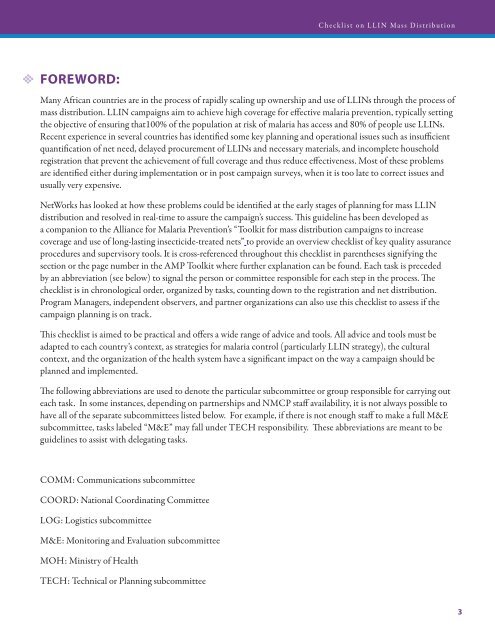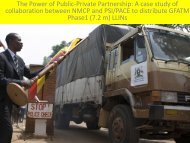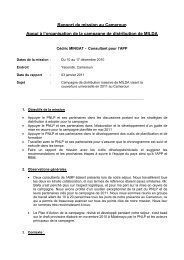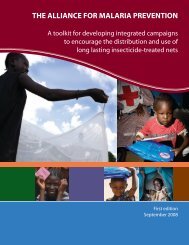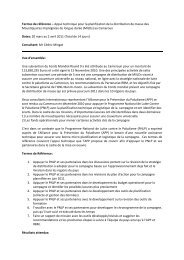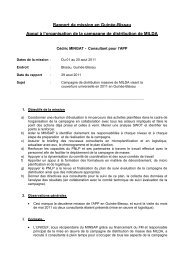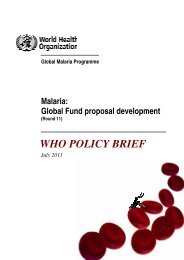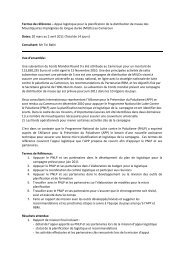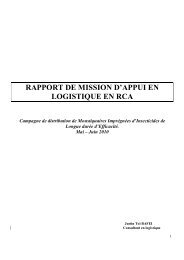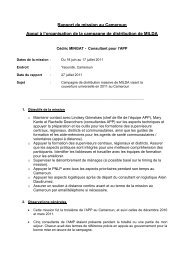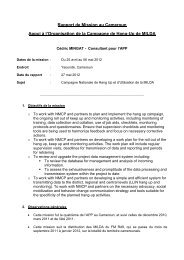Checklist for Program Managers and Independent Observers
Checklist for Program Managers and Independent Observers
Checklist for Program Managers and Independent Observers
- No tags were found...
Create successful ePaper yourself
Turn your PDF publications into a flip-book with our unique Google optimized e-Paper software.
<strong>Checklist</strong> on LLIN Mass DistributionFOREWORD:Many African countries are in the process of rapidly scaling up ownership <strong>and</strong> use of LLINs through the process ofmass distribution. LLIN campaigns aim to achieve high coverage <strong>for</strong> effective malaria prevention, typically settingthe objective of ensuring that100% of the population at risk of malaria has access <strong>and</strong> 80% of people use LLINs.Recent experience in several countries has identified some key planning <strong>and</strong> operational issues such as insufficientquantification of net need, delayed procurement of LLINs <strong>and</strong> necessary materials, <strong>and</strong> incomplete householdregistration that prevent the achievement of full coverage <strong>and</strong> thus reduce effectiveness. Most of these problemsare identified either during implementation or in post campaign surveys, when it is too late to correct issues <strong>and</strong>usually very expensive.NetWorks has looked at how these problems could be identified at the early stages of planning <strong>for</strong> mass LLINdistribution <strong>and</strong> resolved in real-time to assure the campaign’s success. This guideline has been developed asa companion to the Alliance <strong>for</strong> Malaria Prevention’s “Toolkit <strong>for</strong> mass distribution campaigns to increasecoverage <strong>and</strong> use of long-lasting insecticide-treated nets” to provide an overview checklist of key quality assuranceprocedures <strong>and</strong> supervisory tools. It is cross-referenced throughout this checklist in parentheses signifying thesection or the page number in the AMP Toolkit where further explanation can be found. Each task is precededby an abbreviation (see below) to signal the person or committee responsible <strong>for</strong> each step in the process. Thechecklist is in chronological order, organized by tasks, counting down to the registration <strong>and</strong> net distribution.<strong>Program</strong> <strong>Managers</strong>, independent observers, <strong>and</strong> partner organizations can also use this checklist to assess if thecampaign planning is on track.This checklist is aimed to be practical <strong>and</strong> offers a wide range of advice <strong>and</strong> tools. All advice <strong>and</strong> tools must beadapted to each country’s context, as strategies <strong>for</strong> malaria control (particularly LLIN strategy), the culturalcontext, <strong>and</strong> the organization of the health system have a significant impact on the way a campaign should beplanned <strong>and</strong> implemented.The following abbreviations are used to denote the particular subcommittee or group responsible <strong>for</strong> carrying outeach task. In some instances, depending on partnerships <strong>and</strong> NMCP staff availability, it is not always possible tohave all of the separate subcommittees listed below. For example, if there is not enough staff to make a full M&Esubcommittee, tasks labeled “M&E” may fall under TECH responsibility. These abbreviations are meant to beguidelines to assist with delegating tasks.COMM: Communications subcommitteeCOORD: National Coordinating CommitteeLOG: Logistics subcommitteeM&E: Monitoring <strong>and</strong> Evaluation subcommitteeMOH: Ministry of HealthTECH: Technical or Planning subcommittee3


